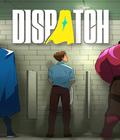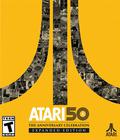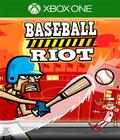Last year, 10tons Ltd. released its mobile game Tennis in the Face exclusively on the PlayStation family of systems. It may not have been the most original of titles, but it remained a fun experience, and those who had initially dismissed the game would wonder where the time had gone once they actually picked it up. Roughly one year later, you have Baseball Riot, the spiritual successor that is also on mobile but has been ported exclusively to the Xbox One.
You play the role of Gabe Carpaccio, a star baseball player who was forced into retirement due to a supposedly wild pitch to the knee. As he languishes as a salesman of used sporting goods, his former team is bought up by the energy drink company Explodz. Enraged that the company did this, he goes wild and sets off on a one-man crusade to free his former team from their clutches. In this case, freeing your team means hitting everyone with baseballs, and since you're no pitcher, you swing a bat to hit those baseballs at your foes to knock them out.
If you haven't played Tennis in the Face before, then the gameplay will likely remind you of Angry Birds in a way. You start each stage firmly planted in one spot while enemies stand in their own given spots. Armed with only three baseballs, you have to aim and angle your hits so you can hit as many foes as possible using those three balls, a task that is helped out by the fact that the baseballs still travel after hitting a target, so it is entirely possible to hit multiple people in one shot. Enemies start off being rather pedestrian as you face fans who are hopped up on Explodz. Soon you'll face catchers who can stop the ball if it lands in their oversized mitts and umpires who are protected in the front but vulnerable in the back. It doesn't take long before you face adversaries from the previous game, such as hipsters, their shield-bearing variant, and scientists in hazmat suits.
Aside from the enemies and the devious floor angles used to construct each level, you'll also face other obstacles designed to be a hindrance to your cause. Glass, for example, may shatter when hit, but it also cancels out your ball. The same goes for balled-up metal shards, though at least they move from the ball's impact. At the same time, there are a few environmental objects that are designed to help you out. Explodz bottles may disintegrate your ball on contact, but their explosion also means that nearby enemies and objects will get hit as well. Baseball silos spread extra balls in all directions once they burst open. Also, objects that come in contact with enemies will knock them out, so hitting them hard enough can get foes that would normally be out of your reach. This also happens to work for the bodies of fallen enemies.
On the surface, the game seems pretty much the same as Tennis in the Face. There's a good mix of challenges thanks to the level design. Some places require you to come up with finding the perfect angle to get that hard-to-reach foe while others make you think about how you can use your environment to your advantage. The challenges may be tough, but the game gives you some really fast restarts that save your last cursor position if you hit the restart button before the failure screen appears. Luck plays a good part in determining success or failure, as the physics system can sometimes produce pretty random results even if the same spot is hit twice in a row.
There are two major changes that both help and hurt the title. The first is the ability to gain extra balls in a stage. You'll always start each stage with three balls in your arsenal. However, if you can hit three enemies with just one ball, you'll gain an extra one to use in that stage. It isn't just ball hits that count for this, as objects exploding or coming in contact with foes and knocking them out also count for this bonus. It may seem like the game is made easier from this addition, but after seeing some of the later stages, the difficulty remains the same no matter how many balls are in your reservoir.
The second change is actually a more significant one: the presence of stars in each stage. Your objective is still to knock out all of the foes, but you no longer get a star ranking for your ammo efficiency. Instead, you're now ranked by how many stars you pick up. You can essentially pass any stage without getting any stars at all, making them seem like optional bonuses for completionists.
But this isn't the case at all. The gates for each stage are governed by stars collected. Furthermore, the only stars that count against that gate are ones obtained in that area, so returning to previously unlocked areas to farm for stars doesn't help at all. On one hand, this solves the previous game's problem of being too easy, as you could easily pass most of the levels without much difficulty, giving the game a shorter lifespan since you could go through a great deal of the stages before getting stuck. On the other hand, with the stages varying wildly in difficulty early on, you'll hit that wall sooner than later, and the feeling of the grind comes in faster. You won't mind this much if you're playing the game in short bursts, but the feeling of fun starts to ebb away if you try to marathon it without aiming for all of the stars the first time out.
The presentation remains at the same level as its predecessor ¾ so much, in fact, that you might not be able to tell the difference unless you looked at your character. The music, for example, carries a light vibe that works well in a puzzle game but also feels oddly familiar to the previous title. The same goes for the backgrounds, which becomes more apparent when you reach the later stages and see the same foes from the older title. Still, the bright colors and hard square style look good, and the animations can be goofy enough that you don't mind seeing them repeated multiple times.
Baseball Riot's changes over Tennis in the Face make it more challenging, but the level of fun you'll have with the title remains the same. Levels are well designed even if some can be frustrating to wade through, and the enemies are nicely varied even if there aren't too many changes. The idea of grinding to unlock stages can be a turn-off for some, and there might not be enough variation for Tennis in the Face players to give this a spin, but for those who only have an Xbox One, this is a pretty good puzzle game for the $5 price tag.
Score: 7.0/10
More articles about Baseball Riot











 Baseball Riot is a humorous, physics-based puzzle game.
Baseball Riot is a humorous, physics-based puzzle game.




